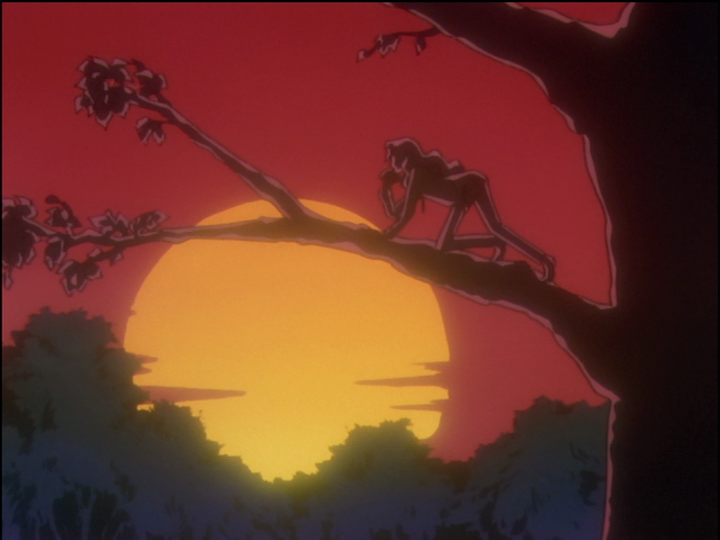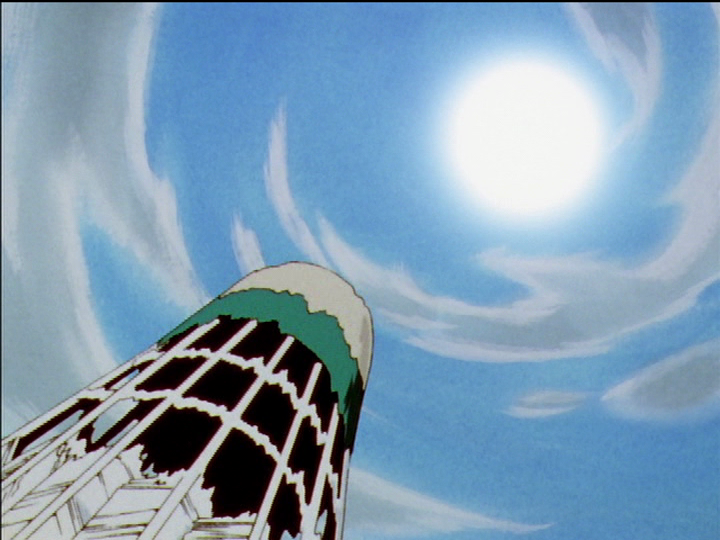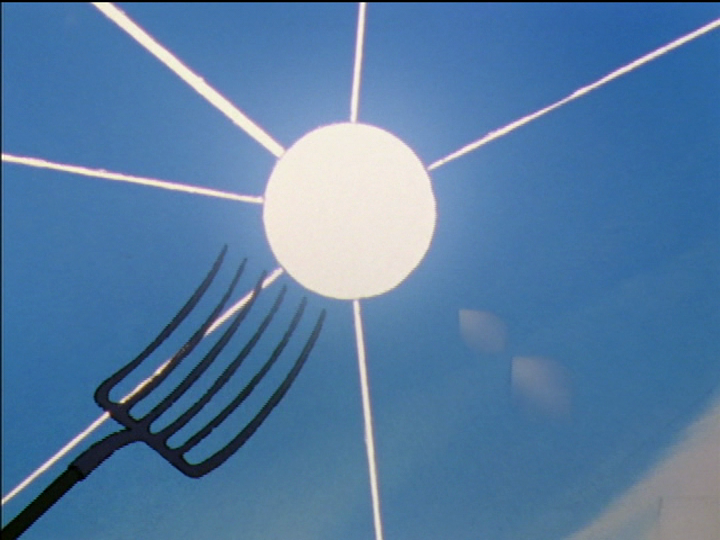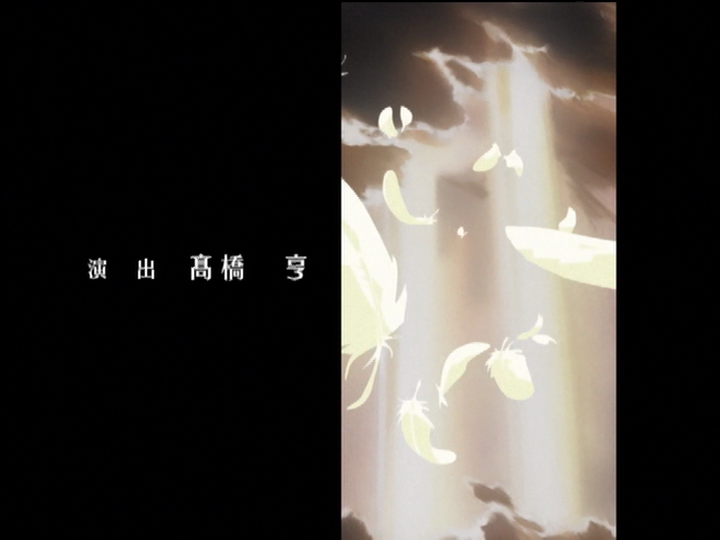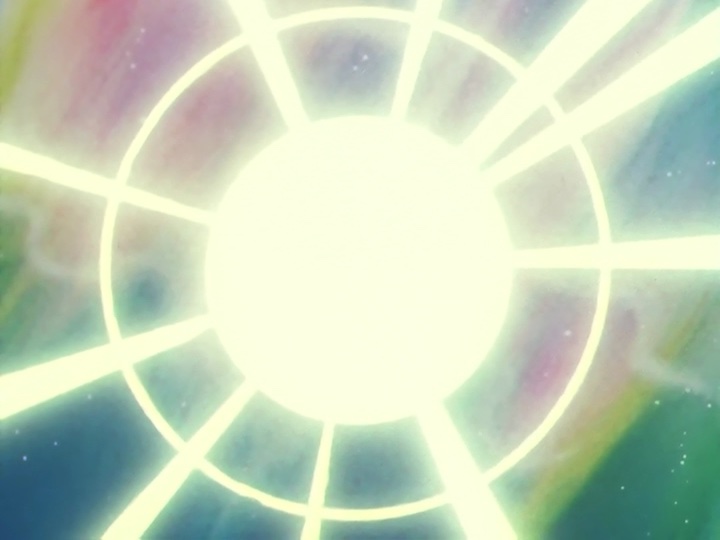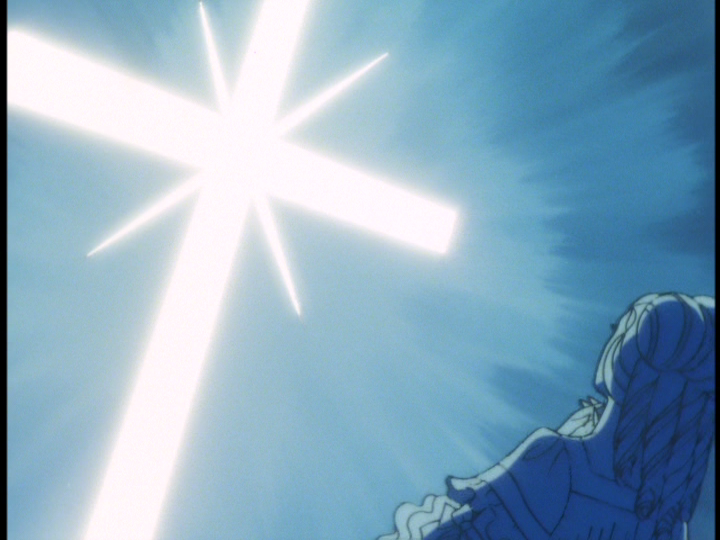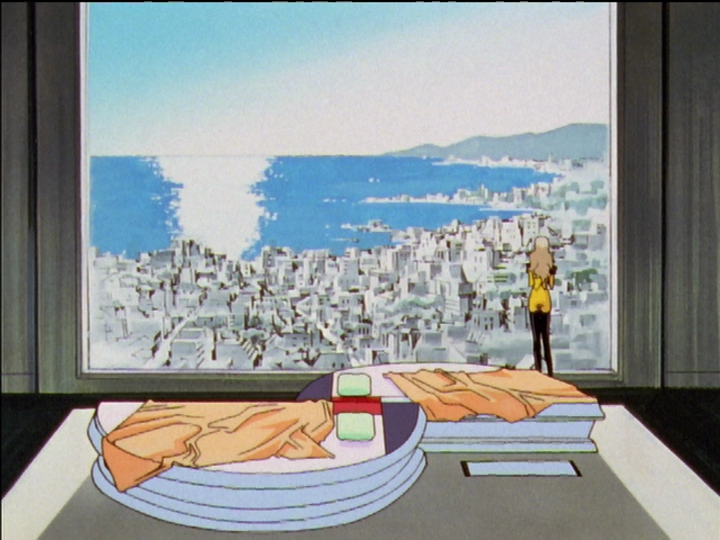Utena - sun catalog
Every depiction of the sun is different, but the images call out to each other. The different suns seem to relate to power or success, and truth or insight. In some, the sun seems to represent a goal to aim for. In The Tale of the Rose, Dios is called “the light of the world”, and when he is trapped the world falls into darkness. Dios is the white sun. Suns of other colors are not the prince’s white and are not Dios, or are not entirely Dios.
White sunbeams across an image represent the prince or princeliness. Commonly they point to a prince. Sunbeams coming down to the left point out a false prince. Two examples with leftward sunbeams are Akio sitting under a tree (a false prince) and sunrise at the start of episode 37 (Utena is dropping the ring, giving up on being a prince). In episode 1, when Utena is under the tree with Wakaba deciding to avenge her, she gets leftward sunbeams. In the next episode, recovered Wakaba in the classroom gets rightward sunbeams.
Dios is the light of the world and Akio is the darkness of the world. Dios and the white sun are associated with truth, with rescue, and with moral goodness. Akio and black night are associated with illusions and lies, with harm, and with corruption and evil. Both are associated with power and with desire and sex; they are not much different overall. Utena blowing out the candles in episode 30 and turning out the lamp in the First Seduction of episode 33 both represent Utena making a moral decision to act corruptly, to move from light to darkness. The sun is associated with love, which lights the world, in the Second Seduction. Night is associated with sex (by and for which men control women) in the First Seduction, and with marriage (by which a man gains final control over his wife) in the Routine Date. See light and dark for more discussion.
Jesus calls himself the light of the world, so Dios is Jesus. See Christianity - Dios. His follower Utena is Jesus too.
See religion - Manichaeism for the light and dark in the world.
Akio is associated with Venus, as he says in episode 25, which (he claims) cannot shine in the day—his power is greatest at night and fades with sunrise. It is because Venus is near the sun in the sky: The sun and Venus are related because they are close together (Dios and Akio are barely different in nature), and opposed because the sun is out only in the day, and Venus is out only at night. See the sun rays in episode 16 below. The sun sometimes brings miracles. As Zeus, Akio is the most powerful Greek god (and Mikage’s lair is also a holy place), making him similar to the Christian God; he has great control over events in the church in episode 9; he executes the Second Seduction in broad daylight, even seeming to subvert the halo around the sun.
In reality, it is possible to see Venus in the sky in daylight. You have to know exactly where to look.
We never see Venus on the screen, even as a projection. When Akio points to it in episode 25, he is pointing offscreen. Utena doesn’t see it either; she doesn’t look. Illusions are invisible when we are deluded by them.
Chu-Chu and Saionji have been body-swapped. It’s the only sunset sun we get to see (though sunset skies and sunset lighting are frequent). This sun is orange and yellow, not the white sun of truth. This sun and the sun of Nanami as a cow being carted away are the only negative sun images; all other suns suggest something positive. They are also the only two greatly oversized suns.
See art - traditional Japanese art for a little more on the image.
In the Dona Dona story of Nanami being carted away for slaughter, a gigantic sun silhouettes everything. The sky is purple; it is not the white sun of truth. Compare the gigantic moon also in this episode.
Nanami, feeling great because of her marvelous cowbell, throws a tennis ball high into the sun before serving it past her opponent. Here it has just started on its way; it becomes an invisible dot in the sun. This sun is tinted yellow, Nanami’s color.
Hitting around a badminton shuttlecock with Juri and Miki, Utena casually hits the shuttlecock far into the sky, next to the sun. It comes down about 15 seconds later. She does it again after a while, and it does not come down at all. Sending the birdie to fly near the sun, not into it like the tennis ball, would seem to make it resemble Venus. Utena sees the truth, but is still missing her target by a little (the suicide conversation hasn’t happened yet). Or something like that.
Nanami thinks her cowbell is radiant like the sun. (Compare the Japanese rising sun military flag (Wikipedia), with red sun rays.) Later, six strange rays project from the sun in the sky. Coincidentally, a six-tined pitchfork is flying past. See mysteries for more. The pitchfork must be related to the tennis ball and shuttlecock above, though it is passing by rather than being thrown upward. That’s four sun references in one episode. Hmm, maybe it’s something important?
The solid sun rays are similar to the indrawn rays of illusion when a sword is pulled from a duelist’s chest in the arena. The ball of light when a sword is drawn in the arena is Dios as the sun. Throwing the pitchfork (which Utena uses like a sword) across the sun corresponds to drawing a sword from a heart. That’s an important part of the meaning, but there is more to it.
There must be a connection with the sun rays at the end of the Apocalypse Saga ending credit sequence, which is Anthy’s wish-fulfillment fantasy. Light shining through storm clouds should stand for dawning hope. The feathers are surely angel feathers to contrast with the devil Akio.
I found three similar anime scenes. In Sailor Moon SuperS, there’s a flashy lighting effect when Pegasus (the flying dream unicorn that corresponds to Dios, who is the sun) appears in the sky. Chibi-Usa calls down Pegasus with a short prayer, and Pegasus provides help in the form of power to defeat the monster of the week. In The Rose of Versailles, Marie Antoinette prays to a Christian cross shining like the sun in the sky. She is calling on God for help. In The Vision of Escaflowne, protagonist Hitomi dreams of reaching toward a sun with six rays. The sun resolves into an angel that flies down to rescue her, prefiguring an actual rescue later in the episode. Hitomi is also reaching out for help. The second two, and maybe all three, associate the sun with the Christian God and imply that God can give salvation, whether theological or literal. They connect with Dios’s rescues, since Dios is the sun.
Three appearances with similar meanings—that’s a trope, even if I don’t recognize it at all. It ties in to a wider cross-cultural symbol complex about the sun and sunlight; the sun nurtures life and it is powerful and pure white. In Christianity, the sun is associated with God, also seen as life-bringing and powerful and pure. All these images (even Nanami’s yellow sun) associate sun rays with rescue or salvation. In the broadest view, light is good and darkness is bad.
The cowbell is Nanami’s perceived sun, not a real sun. It is a yellow sun of jealousy that gets her in trouble. The white sun rescues her, getting her out of trouble again. The pitchfork is the means of rescuing her—Mitsuru is throwing it to Utena, who uses it to remove the cowbell. The pitchfork metaphorically aligns with Chibi-Usa’s and Marie Antoinette’s praying hands and Hitomi’s reaching hand; it is Mitsuru reaching out for help (Nanami doesn’t think she needs help).
Some other items worn around the neck are connected to the cowbell. Is the tie of the girls’ uniform a cowbell for them all?
Here are the sun rays again. The six rays and six tines should stand for the six duelists. The thicker one must be Utena. Three are tilted left for illusion, and three right, which fits with Utena’s half-and-half world. The ray pointed most leftward is also the one closest to Utena, and should be Utena’s friend Miki who is the most deluded by illusions. The remaining leftward ray should be Nanami, the next most deluded duelist. The upward pointing ray should be Touga, who Utena feels some closeness to and who Akio must see as the most upright of them. Then the downward ray is Saionji (Touga’s opposite and distant from Utena) and the northeast ray is Juri. The pitchfork passes along the Nanami-Juri axis, as the episode itself does.
None of this is firm, because there’s not enough evidence to double-check it. But it hangs together.
When the pitchfork lands in Utena’s hands, it has five tines. Removing the cowbell is presented as if it were a duel: The duelist Nanami is eliminated. In episode 29, Juri (the other duelist on the axis) is eliminated. Juri’s ray is the only one with irregular thickness.
Mikage holds up his tears to the overhead light in the confession elevator. The light is not the sun, but it’s treated as though it were; the white light of truth in the confession elevator is the sun of the underworld. Actually it’s not quite white; it is tinted faintly blue-green for illusion. I count seven rays from the light. They may be the seven duelists who fight Utena in the Black Rose. Or they may be the six above plus Mikage (the angles roughly match). Or maybe they’re just decorative.
It’s an image of reaching for the sun, like the pitchfork above. It matches the Escaflowne image particularly well. Mikage makes a truthful confession, holding up his truth to the light—the sun grants him that much help—then falls increasingly into delusions in the runout. Mikage in his underworld is sad and lonely, like his parallel Utena.
Saionji is lying on the floor of Wakaba’s room, looking blankly upward through the window toward the sun far above his head. Next, the sun appears immediately above Wakaba’s head as she wins in a race—compare Utena’s sports superskills, a sign of Utena’s power. The race, and Wakaba’s tennis tricks, are hints of Wakaba’s future.
The sun seems to represent their true desires. Saionji is separated from his desires by distance and a glass window, which explains why he is so pleasant while staying with Wakaba. Wakaba feels near her desires. She is special, and winning the race to her prince. It connects to the sun shower that Utena notices later (and of course to the shadow play). The sunshower seems to match up with Anthy watering her roses. It may remind us that the sun does not rule the day uncontested; water is an agent of illusions.
The sun is high in the sky as Utena rides on Touga’s horse shortly before falling (episode 35). The view repeats when she rides Akio’s horse (episode 36), not much later in real time and shortly before she falls for Akio’s seduction. The sun is surrounded by a 22° halo. The halo is caused by thin clouds of ice crystals high in the atmosphere—in other words, by water, an agent of illusions. I don’t know whether the creators knew or cared about that, but it does add a layer of meaning. The halo is a religious symbol, God’s halo, a halo around the truth. I take it that the first halo is for Touga’s genuine love of Utena and the second for Utena’s genuine love of Akio. See date parallels - light and dark for that line of symbolism, and catalog of halos for more halos. The white sun also refers to the rescuing prince that Touga wants to be and that Akio pretends to be.
I think the white sun also means that Dios approves of seducing Utena. He would do it too, by different means.
The halo is a ring—a wedding ring. Touga and Akio each wants to control Utena through marriage.
The reason I doubt that the creators knew that the 22° halo is created by ice is that we see it disappear when the sun goes behind trees. The ice crystals are high in the atmosphere, so that’s not how it works; when the sun is hidden the halo is still there. Of course, you could take that to mean that the halo itself is an illusion.... See flawless art.
There are three sunrises where the bedsheets miraculously turn orange at the moment of sunrise, letting us know of a potential miracle. In episode 37, there is an actual miracle. In each case, the color can also be interpreted as (perceived) one-sided love. They happen when characters stay awake through dawn, depriving Akio of the influence he exercises through their dreams.
It seems as though the three sunrises should be three challenges of a fairy tale. If so, I don’t know what challenges they are. Since the last one has a different outcome that is good for Utena, I think they must be Akio’s challenges: He succeeds at two and fails the final one. It connects with Akio’s failure in proposing marriage to Utena in the Routine Date, the third of another set of three challenges (see Akio-Utena overview - fairy tale plot), but I don’t see the shape of the connection yet.
Episode 32. It is after Nanami saw Anthy and Akio together. The sun has already risen; we don’t see Nanami at the moment of sunrise. One-sided love: Nanami believes Touga does not care about her.
Between the halves of the S-shaped bed there is normally a purple patch, where Utena and Anthy’s hands rest when they hold hands. It is purple for Anthy’s corruption, and perhaps foretells Utena’s corruption. When Nanami sleeps there, the patch is red. I think the color changed to red at sunrise, at the same time the sheets turned orange.
Episode 36. The only sunrise where we see the sun. It is after Utena and Touga visited the dueling arena at night. Utena was looking away at the moment the sun rose, and was not enlightened. One-sided love: Touga loves Utena, who does not love him back. She enjoyed the night with him, though; it corresponds to episode 37 where she enjoys the Routine Date with Akio but figures out that she does not want to marry him. Could the yellow around the sun be Dios’s jealousy that Utena is turning away from him?
Before sunrise, Cassiopeia was in the sky (see after the Routine Date - the star symbolism). Its orientation implied that the North Star was below the horizon; it was a southern sky. Metaphorically, it means that the truth was out of sight. Saionji’s voice from the next shot overlaps: Do you have your answer?
Episode 37. It is after Utena saw Anthy and Akio together. We don’t see the sun—information is being withheld from us—but Utena did, and she remembers part of the prince story. It’s a miracle. Utena is enlightened. She doesn’t understand much at first, but she begins to look around outside her coffin and learns rapidly. It’s a key event, and a necessary step in Utena’s victory. Though the camera is lower and we should see less of the city, in fact we see more of it and it seems closer and clearer. Utena is seeing more, and seeing more clearly. The sunbeams are angled left, as usual with Utena, and she stands on the left side of the frame. One-sided love: Utena believes that neither Akio nor Anthy loves her, even as she loves both.
The camera angle hides the usual purple patch on the S-shaped bed. Later we see that it has turned red, as it did for Nanami.
